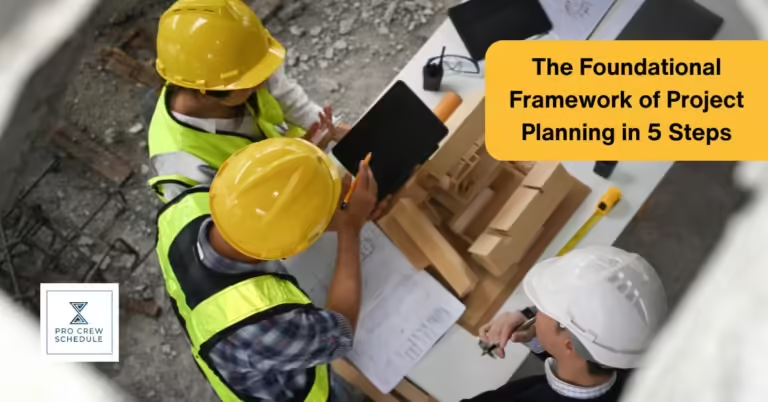The construction industry has been growing more rapidly than ever, and there is no stopping it. Projects are becoming more complex, the demand for efficiency continues to rise, and the expectations for sustainability are increasing. Seeing these changes in the past few years, construction professionals are now exploring out of their comfort zones and experimenting with methodologies, especially in the construction phase, which sets the tone for executing the whole project—the planning phase.
But before you think of the most advanced solutions in construction planning, let’s must first examine the basics of planning, which serve as a dependable blueprint for industry professionals to use. This is where the 5Ps, the most fundamental framework of planning, come into play. The 5Ps stand for Proper Planning Prevents Poor Performance.
In this article, we’ll examine the 5Ps of construction planning in-depth and learn strategies for applying them in management to improve execution and overall outcome.
What are the 5Ps in the Construction Industry?
One of the oldest but overlooked methods in construction planning is the 5Ps, which offers a systematic approach to planning that aims to mitigate risks and increase the chances of a successful project. The 5Ps look at each aspect of what makes construction planning successful, and it’s better to look at each more deeply to better understand the 5Ps concept.
1. Proper
The construction industry is the same as others in terms of the cornerstone of a successful project, which lies in the successful planning stage. Before you start anything, you must plan with absolute thoroughness, or you can anticipate problems in the next phases of your project. However, keep in mind that proper planning is not just about sketching out milestone timelines and allocating resources; it includes careful analysis of your feasibility studies, stakeholder consultations, environmental assessments, and legal compliance checks.
Moreover, alot of due diligence is conducted beforehand during planning, some of which can be considered as metrics to confirm whether a certain construction project will succeed or not.
Proper planning is important for setting a solid foundation for any kind of work and it involves meticulous research into cost estimation, labor requirements, as well as material schedule in construction. If you provide your team an ample time and resources to really deep dive into this phase, you can already anticipate potential difficulties that can happen and formulate effectives strategies to mitigate them early. This way, successful and headache-free execution is ensured for you and your team.
To help you properly plan better, here are some of the strategies you can employ now in your construction planning gameplan:
Use Advance Construction Management Tools
Proper planning, not just planning, involves a multifaceted and exhaustive approach in way of doing things. First, you need to have a comprehensive understanding of the project’s objectives, strengths, and other constraints.
To even more effectively apply proper planning into your workflow, you should learn next how to leverage advanced construction management tools for your feasibility studies and risk assessments. Doing this can ensure that all the littlest elements of your project, including material availability, site conditions, legal requirements, and community impact, are thoroughly looked into before anything is started.
Develop a Comprehensive Project Charter
Additionally, creating a comprehensive project charter outlining the project’s scope, objectives, goals, and key stakeholders will be a critical step in ensuring the planning phase is as efficient as possible.
2. Planning
Now that you have internalized the mindset of having a “proper” foundation, you can explore the planning portion of the 5Ps. In construction, planning involves the bird’s eye view look of what your project has in store—detailed stratification of the construction crew scheduling, laying out clear objectives, establishing milestones— and your task as a construction manager is to make a game plan to reach these goals.
Anticipate What Could Go Right and Wrong
Against popular belief, effective planning doesn’t only focus on what you can do right; it also means investigating what can go wrong. Planning also means making a plan to mitigate problems before they even happen. Moreover, you’re also expected to be flexible in employing a dynamic attitude to anticipating changes in the project scope, unforeseen issues, and spontaneous changes in the shareholders’ expectations.
Now that you have a good visual of your project trajectory and do’s and don’ts, it is easier to outline your schedule, scope, budget, and delegation. Every stakeholder and worker in the project will be on the same page, which translates to better collaboration and coordination.
Adapt Critical Path Method
Boosting your construction planning efforts requires a strategic and proactive mindset, which means you have to look into different paths. This mindset includes using scheduling tools and techniques, like the Critical Path Method (CPM), to create detailed timelines for your project that are flexible and ready for any changes that can happen.
Early in the project, working cross-disciplinary with your workforce will guarantee that their viewpoints and areas of expertise are taken into account. Additionally, you may accomplish two goals at once by doing this and building a strong team and detailed plans for the future of your project.
Consider Building Information Modeling (BIM)
Utilizing Building Information Modeling (BIM), a technology that enables the creation of digital representations of a construction project’s functional and physical properties, is another effective practice. BIM facilitates simulations of processes and sequences and offers a thorough project representation, which makes decision-making during the planning phase much easier.
3. Prevention
As the saying goes, “Prevention is better than cure,” this holds particularly true in managing construction projects. The 5Ps step involves identifying potential pitfalls that the project can experience, from scheduling delays to budget overruns and developing contingency plans as early as possible to address these risks.
Create a Risk Assessment Plan
Foreseeing and preventing issues before they manifest in construction can significantly help a team drive the project toward success, save time and money, and gain a stellar reputation with current and potential clients.
One proactive prevention measure in construction management involves regular risk assessments and the creation of mitigation strategies. This involves establishing a risk management plan, a living document that identifies potential project risks assesses their impact and prioritizes them based on the likelihood of them happening and their severity.
Implement QA and QC Processes
It is crucial to strictly implement standards for quality assurance and quality control to avoid issues related to construction quality. Consistent on-site inspections, adherence to construction standards, and ongoing quality training guarantee that the project meets or surpasses the quality standards established by the stakeholders and management.
In addition, effective strategies for preventing problems in construction management involve engaging stakeholders and putting quality control measures in place to avoid legal disputes as the project begins.
4. Poor
In life and work, inadequate preparation for any goal can lead to a myriad of issues; in construction, it means project delays, safety incidents, cost overruns, and compromised quality. The project’s results can be affected by these frequent yet avoidable mistakes, leading to potential long-term effects on your company’s financial well-being.
Establish a Communication Platform
To avoid poor performance in managing construction projects, it’s crucial to establish clear communication channels where you can set realistic timelines and budgets. The project scope should be clearly defined, and all team members should be informed of changes.
Regular progress monitoring using crew planning software and performance metrics permits early detection of changes in plans and specifications, allowing for timely adjustments.
Use Lean Construction Principles
Adopting lean construction principles can also considerably improve project performance by minimizing excess waste and maximizing value through continuous optimization of set construction processes. Adopting lean methodologies means streamlining workflows, lessening material waste, and improving employee efficiency.
5. Performance
Generally speaking, integrating the 5 Ps in any construction management aims to optimize not only specific aspect of the project, but the overall performance of it. In order to make this happen, a list of pre-defined objectives regarding a project’s scope, cost, time, and quality should be set in place. If you have attained a high performance in these areas, it means that you have achieved your project goals according the the 5Ps standard.
Using data and analytics to inform decision-making and concentrating on ongoing improvement are key components of construction project performance maximization. Additionally, you may get real-time tracking and scheduling capabilities by using construction management software like Pro Crew Schedule. This software can also give you insightful data about project progress, resource allocation, and productivity performance in comparison to benchmarks.
Encouraging teamwork and communication is essential to guaranteeing your project’s optimal performance. Therefore, there should always be a single source of truth for all information, updates and criticism.
Key Takeaway
Once you have accepted the construction industry’s complexities, you’ll come to terms with the fact that every phase in the project lifecycle demands excellence. By prioritizing superior quality even as early as the planning phase, you and your team can circumvent problems that lead to poor outcomes later. Moreover, sticking to excellent standards even in the earliest stage of your project ensures that you’ll have an outcome that is delivered within budget, in a timely manner, and at the highest possible quality standard.
Maintaining high-performance levels is very challenging in an industry full of large-scale and complex projects. However, by applying the principles of the 5 Ps and using construction crew management software, project and construction managers can ensure that their projects are not just finished but also exemplary in their execution, setting a benchmark for excellence in their portfolio and the industry.







